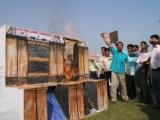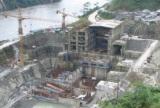MEGA DAM SCARE haunts the NORTH EAST
 As the fragility of the Himalayan range has been exposed by the devastation unleashed by the mega flood in the Uttarakhand areas, it has lent credence to the on-going mass anti-mega dam movement in Assam and Arunachal Pradesh against the numerous mega hydro-electricity dams that are either being constructed or which are proposed to be constructed in the Arunachal Himalayas that are considered not very stable from the point of view of the geological age of the entire range.
As the fragility of the Himalayan range has been exposed by the devastation unleashed by the mega flood in the Uttarakhand areas, it has lent credence to the on-going mass anti-mega dam movement in Assam and Arunachal Pradesh against the numerous mega hydro-electricity dams that are either being constructed or which are proposed to be constructed in the Arunachal Himalayas that are considered not very stable from the point of view of the geological age of the entire range.
With the tragedy that is unfolding in Uttarakhand where the hills and the eco-system have been decimated by the surging waters thereby causing irreparable damage to lives and property, the anti-dam activists in Assam and Arunachal Pradesh have renewed their cry against the construction of mega dams in the upstream of the rivers which flow down to the Assam Valley, in Arunachal Pradesh.
Krishak Mukti Sangram Samiti (KMSS) General Secretary and RTI activist Akhil Gogoi who is spearheading the anti-dam movement along with over 20 other mass organisations, has resorted to a renewed agitation demanding a stop to construction of Mega dams in Arunachal Pradesh.
Pointing towards the devastation in the Uttarakhand hills, Akhil Gogoi has stated that a time bomb is ticking in Assam because of the ‘monstrous dams’ in Arunachal Pradesh. The KMSS and other anti-dam organisations maintain that the construction of dams along the Brahmaputra River and its tributaries in the upper reaches of the river would spell doom for the people and environment of the Assam Valley. Akhil Gogoi has criticized the Central Government for ruling out a review of the proposals for construction of big dams in the North East.
During her visit to Assam last year to extend her support to the anti-dam movement, the country’s most renowned crusader against mega dams Medha Patkar said that the anti-big dam agitation in Assam was now snowballing into a national movement for the mass support it had generated and the struggle is resounding from ‘Narmada to Brahmaputra’. Addressing an anti-big dam rally organised by eight agitating organisations at Chauldhuwa in Assam’s North Lakhimpur district, Ms. Patkar said, “This struggle against big dams is going on in Assam and has transformed into a national movement now.”
| Despite the protest from the people of Assam and the concerns raised by the Assam Government the MOEF had finally given the wildlife clearance to the Lower Demwe project citing the need for development. |
She congratulated the people of Assam for building up the movement against big dams, particularly the 2000-MW Lower Subansiri Hydel Power Project being constructed by the NHPC at Gerukamukh in the Assam - Arunachal Pradesh border. “This dam will render people homeless and snatch away their means of livelihood. This must be stopped and the determination of the people encourages me to believe that the people’s power will prevail,” Patkar said.
Meanwhile, groups agitating against the Lower Subansiri project of the NHPC have renewed their demand for the scrapping of all the proposed big dams on the Brahmaputra River and its tributaries.
Assam Chief Minister Tarun Gogoi who has been rooting for the construction of the 2000 MW Lower Subansiri Hydro Electric Power Project (LSHEP) at Gerukamukh in Dhemaji district along Assam-Arunachal Pradesh boundary, has now advocated for a proper and detail downstream impact study in respect of all the mega dams that are being carried out in Arunachal Pradesh as he has apprehended that another Uttarakhand - like tragedy may unfold in Assam and Arunachal Pradesh because of the construction of these dams in a fragile eco-system in Arunachal Pradesh.
Gogoi has also stated that Assam might face a disaster not because of dams in Arunachal Pradesh only but also those in the Tibet region of China bordering the region.
 Regarding the NHPC project Gogoi maintains that the Assam Government will not do anything that will go against public interest. “Today, there are ways and expertise to even rectify the designs of dams, if necessary, to minimise any adverse impact,” Gogoi said.
Regarding the NHPC project Gogoi maintains that the Assam Government will not do anything that will go against public interest. “Today, there are ways and expertise to even rectify the designs of dams, if necessary, to minimise any adverse impact,” Gogoi said.
The on-going agitation against the construction of mega dams in the tectonically unstable Arunachal Himalaya and Assam - Arunachal Pradesh boundary areas was intensified after the Ministry of Environment and Forest (MoEF) last year gave a wildlife clearance to the 1760 MW Lower Demwe Hydroelectric Power Project on the Lohit River in Arunachal Pradesh. The Assam Government had earlier registered its protest against the project apprehending that it would have detrimental downstream impact on the environment and wildlife. However, Arunachal Pradesh had informed the Centre that downstream impact can be studied during the construction of Lower Demwe project which should be cleared as it will not affect the Dibru - Saikhowa National Park in Dibrugarh district of Assam. “The downstream impact is limited to a few months of the lean season and will be confined to low-lying flood plains in the Brahmaputra basin. This impact can always be studied during the construction of the project,” it said.
The MoEF decision to give wildlife clearance to the dam project evoked a sharp reaction from the side of the anti - dam agitation led by the KMSS. The KMSS General Secretary Akhil Gogoi and Secretary and President Raju Bora stated that despite the protest from the people of Assam and the concerns raised by the Assam Government the MOEF had finally given the wildlife clearance to the Lower Demwe project citing the need for development. “This has again proved how insensitive the Indian Government is and also how helpless the Assam Government is,” said KMSS and claimed that nowhere in the Ministry’s order was the concern of Assam mentioned and sincerely addressed.
 The KMSS flayed the MoEF for ignoring what Dr. Asad Rehmani of Bombay Natural History Society had earlier highlighted about how disastrous this project would be for Assam. Dr. Rehmani submitted a full length report on the Lower Demwe citing massive ecological damage in the downstream areas of the dam. At the 24th meeting of the Standing Committee of the National Board of Wildlife which met on 13th December 2011 all the non - official members supported Dr. Rehmani’s proposal for the rejection of this project. Dr. Rehmani also suggested for additional studies in the coming years. The report especially mentioned the formation of an independent consortium of scientists to review the project. The KMSS leaders said, “This has again proved how the Assam has turned out to be the worst victim of the present hydro-power policies of the Government of India which tends to completely ignore the presence of Assam and its people in the downstream areas of this project.”
The KMSS flayed the MoEF for ignoring what Dr. Asad Rehmani of Bombay Natural History Society had earlier highlighted about how disastrous this project would be for Assam. Dr. Rehmani submitted a full length report on the Lower Demwe citing massive ecological damage in the downstream areas of the dam. At the 24th meeting of the Standing Committee of the National Board of Wildlife which met on 13th December 2011 all the non - official members supported Dr. Rehmani’s proposal for the rejection of this project. Dr. Rehmani also suggested for additional studies in the coming years. The report especially mentioned the formation of an independent consortium of scientists to review the project. The KMSS leaders said, “This has again proved how the Assam has turned out to be the worst victim of the present hydro-power policies of the Government of India which tends to completely ignore the presence of Assam and its people in the downstream areas of this project.”
EXPERT GROUP’S VIEWS
An Expert Group comprising experts from Indian Institute of Technology (Guwahati), Gauhati University and Dibrugarh has already given its opinion against the construction of the mega dam by the National Hydroelectric Power Corporation Limited (NHPC) at Gerukamukh in Dhemaji district along the Assam - Arunachal Pradesh boundary considering the sensitive geological and seismological character of the area.
The eight member expert group was entrusted with the responsibility to carry out a detailed downstream impact study of the 2000 MW Subansiri Lower Hydroelectric Power Project as the NHPC had started that the construction of the dam without bothering to carry out the downstream impact study has triggering widespread mass protests.
The expert committee in its recommendations on the feasibility and the safety of the dam says, ”The selected site for the mega dam of the present dimension was not appropriate in such a geologically and seismologically sensitive location. The seismic design parameter is not properly chosen for the project. Therefore, it is recommended not to construct the mega dam in the present site.”
 Further, the expert group has suggested not considering the geologically young and tectonically unstable Himalayan foothill areas to the south of the Main Boundary Thrust (MBT) for construction of any mega hydropower project. The dam site in question as well as the entire Arunachal Himalayas where 165 dams are being constructed for generation of power is located in a highly seismic and tectonically fragile area.
Further, the expert group has suggested not considering the geologically young and tectonically unstable Himalayan foothill areas to the south of the Main Boundary Thrust (MBT) for construction of any mega hydropower project. The dam site in question as well as the entire Arunachal Himalayas where 165 dams are being constructed for generation of power is located in a highly seismic and tectonically fragile area.
The Committee has recommended redesigning of thee project by sufficiently reducing the dam height and generation capacity.
The initiation of Subansiri Lower Hydroelectric Power Project where the NHPC came into the picture in the year 2000 when the Brahmaputra Board handed over the project to it, had created great apprehension among people in the downstream areas over their fate in the event of a mega earthquake that may cause a breach in the mega dam. Vociferous protests by the people under the leadership of All Assam Students Union (AASU) and All Assam Mishing Students Union led to the formation of the Expert Group following discussion between the Assam Government, the AASU and the NHPC. Members of the Expert Group included Dr. A K Sharma and Dr. Chandan Mahanta of IIT, Guwahati, Dr. Jatin Kalita, Dr. A K Bhagawati, Dr. S Kalita and Dr. B P Duarah from Gauhati University, Dr. S P Biswas and Dr. J N Sharma from Dibrugarh University.
In view of the Expert Group’s recommendation, the AASU leadership demanded an immediate halt in the construction of the mega dam by the NHPC and called upo n the Assam Government to move the Centre to ask NHPC to stop work at the dam site.


